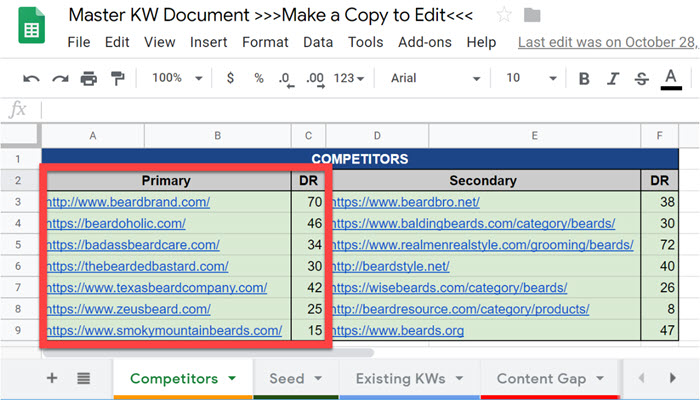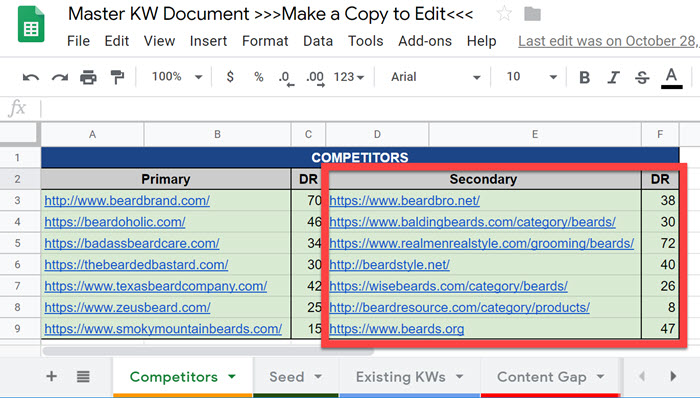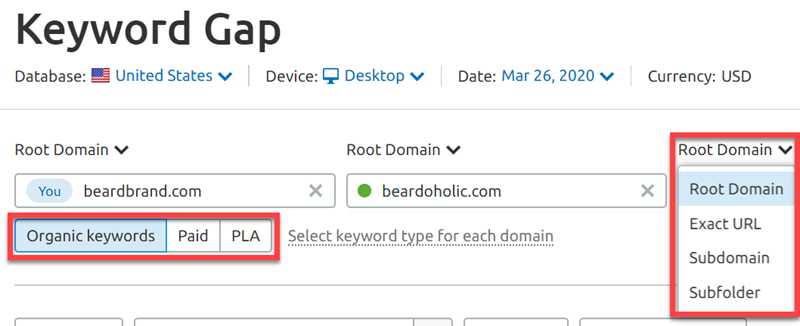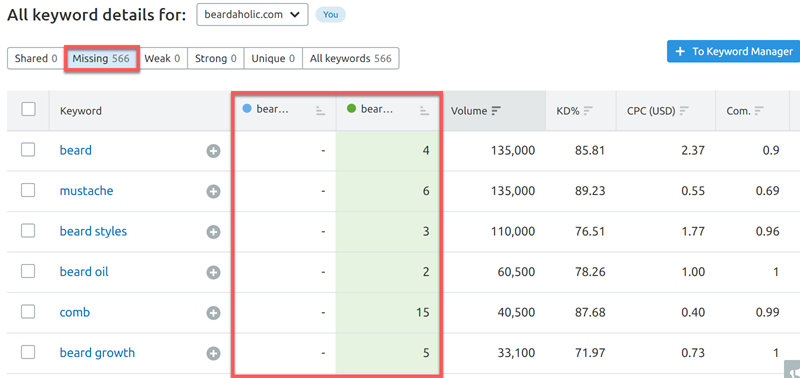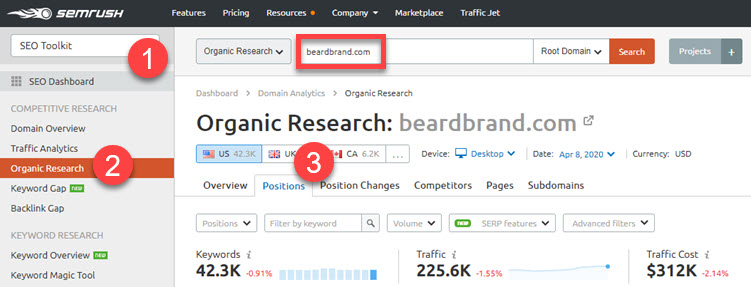Looking to find your competitor's most valuable keywords? Use this simple 5-step process to uncover a trove of new opportunities.
Keywords form the base of any successful SEO campaign.
But, finding the right keywords that drive the right type of traffic to your business can often feel overwhelming, especially if you’re strapped for time.
Luckily, it doesn’t have to be this way:
What if you could reverse engineer the SEO success of others, and exploit their weaknesses to land higher rankings and more organic traffic?
Enter: competitor keyword research.
By finding all your competitor’s top performing keywords you’ll emerge with a proven blueprint for success. No more guessing which keywords drive the most traffic or conversions.
In today’s post, I’m going to walk you step-by-step through a series of competitor keyword research tactics you can use to quickly mine for keyword gold.
Specifically, we’ll look at:
Whether you’re an established business or starting a new website, this guide will give your keyword research process a running start, while laying a rock solid foundation for all your future keyword research and content efforts.
Let’s jump in...
Editor’s Note: If you want to learn the exact keyword research processes I use to scale organic traffic for my clients, check out my premium training course, The SEO Playbook.
You’ll learn how to find, qualify, prioritize and map keyword data:
Screenshots of the Aggregate and Keyword Mapping tabs in The SEO Playbook.
Disclaimer: This article does contain affiliate links. If you purchase a tool through one of my links I will receive a small commission at no additional cost to you.
What Is Competitor Keyword Research?
There are two methods of keyword research.
Traditional keyword research uses seed keywords to build a larger set of related search terms that can qualified, prioritized and mapped to posts/pages on a site. While this process works well, it requires some guesswork, and a lot of upfront legwork.
Competitor keyword research lets you reverse-engineer the keywords that are already driving traffic and conversions for your competitors. It allows you to quickly see where you're falling short, and spot critical gaps in your content strategy.
Editor's note:
Use a competitor-based keyword research tool like SEMrush (affiliate) to quickly discover which high-traffic keywords your competitors are already ranking for across each stage of the buyer journey.
Grab a free 30-day trial (affiliate) and follow along with the tutorial.
Why Competitor Analysis Should Be The Bedrock of Your Keyword Research Process
Time and again you hear about marketers sweating over their content planning. They spend endless hours researching topics and keywords when all they had to do was look at what was already working for their top competitors.
When it comes to keyword research, there’s no need to reinvent the wheel.
It’s much easier to discover what’s already working for your top competitors and do the same. Only better.
Here are seven ways you can use competitor keyword research to plan your content strategy:
- Find new keyword opportunities fast - Analyze your competitors to see what keywords they’re ranking for that you hadn’t thought of yet.
- Find (and fill) important content gaps - See which keywords are driving targeted traffic to the competition that you are missing out on. . Then create or update your content so that it outranks them.
- Find where competitors are beating you - Analyze your competitors to find which common keywords they’re ranking above you.
- Find which terms competitors are bidding on - Keywords that your competitors have been bidding on PPC campaigns over an extended period likely have more commercial intent, so prioritize content creation around those topics.
- Find lower competition long tail keywords - Pages rank for more than one keyword. Drill down into your competitors content to discover low competition long tail keywords you can add to the content calendar.
- Find secondary keyword opportunities - One article can rank for hundreds or thousands of different search terms. Mine top ranking articles for secondary keyword variations/ topics that can help you expand the organic footprint (and traffic potential) of existing content.
- Find featured snippet opportunities - More keywords are triggering featured snippets. If you’re able to pinpoint which topics are triggering them, you can optimize for placement, rank in position #0, and exponentially increase organic traffic potential.
How to Quickly Identify Your Top Primary (and Secondary) Organic Search Competitors
Before you can identify competitor keywords, you first need to know who your competitors are.
This includes both your primary and secondary competitors.
Primary Competitors
Primary competitors sell the exact products or services as you, to the same target audience. Start with them.
Here are two ways to find your primary organic search competitors using Semrush and Google search.
1) SEMrush
Using the Domain Overview report in SEMrush (affiliate), enter your domain in the search bar. For example, “beardbrand.com”:
SEMrush displays all the top-level information for your site including Organic Search, Paid Search, Backlinks, and Keywords:
Scroll down the page to find your Main Organic Competitors. In our example, the main competitors of Beardbrand are Beardoholic, Beard Resource, Beard Style, Zeus Beard, and Balding Beards:
Click on “View full report” to see more details on the common keywords and total keyword/traffic metrics:
SEMrush shows Beardbrand has 9,697 competitors. But we’re most interested in sites that have similar or higher organic traffic (242K), plus a high number of common keywords as this tells us they have the highest degree of topical overlap and potential to highlight new opportunities.
Here’s how to quickly qualify the competition:
Qualify by traffic
At first, exclude sites that have much lower traffic than yours. These sites have a lower probability of delivering any new keyword opportunities.
If you’re a new site, this obviously doesn’t apply.
In our example, Beardoholic (194.5K) and Balding Beards (268.3K) have similar traffic to Beardbrand:
Note: don’t analyze hugely authoritative broad-scope domains in this step. I.e. sites selling loads of different products like Walmart or Amazon. Focus on the businesses selling the exact same products or services as you. We’ll come to the bigger players at a later stage in the process.
Qualify by keyword overlap
Include sites with a high number of common keywords. This will help drill down to the sites with the highest degree of topical overlap.
In our working example, this is Beardoholic and Balding Beards:
Note: While GQ has the highest number of common keywords in this example, it is also a large broad-scope industry publication ranking for almost 2M different keywords. We’ll skip this site since we’re mostly interested in direct competitors selling competing products.
Make a list of at least 3-5 primary competitors.
Screenshot of the Competitors tab in the Master Keyword doc from my training program, The SEO Playbook.
2) Google
You can also check your competition in Google by searching for your products and their alternatives.
Search your product in Google
For example, if you simply enter “beard oil” you can see a potential competitor is Badass Beard Care:
Since the competitor is not a large publications, and is selling the exact same products, I’ll add them to my list of Primary competitors.
Search for your product/brand + alternative
For example, if you search for “what's an alternative to boars hair beard brush” there are several potential competitors including Elegance Beard, Beard Resource, and Balding Beards:
Back in SEMrush (affiliate), you can use the Organic Research Overview report to look at the traffic and keyword position trends over time to get an idea on which competing sites have the best keyword and content strategies in place.
From the four potential competitors found with the previous Google search, Balding Beards looks like another good site to analyze:
Organic traffic has been steadily increasing over the last 12 months, along with the number of keywords ranking in the top 10 positions.
Secondary Competitors
In addition to researching primary competitors, it’s a good idea to broaden your search to neighboring sites which have related content topics that your audience might be interested in.
These sites won’t sell a directly competing product or service, but they will produce content for a similar target audience.
For instance, beardstyle.net is an affiliate website that would be considered a secondary competitor since they don’t sell competing products, but do produce a lot of top and middle funnel content (i.e. reviews, and “best of” articles) read by the same target audience:
In SEMrush, you can see that beardstyle.net ranks for a lot of the higher volume topics, as well as less competitive longer tail keywords including “beard style for curly hair” and “how to style a long goatee”:
Depending on budget and resources, you can also broaden the scope of your secondary competitor analysis.
For instance, Beardbrand targets men who want to groom their beards. But those same men are likely interested in other grooming products like hair styling products.
For example, searching for “men’s hair products” brings up Fashionbeans:
In SEMrush, you can see they rank for keywords including “man bun”, “long hairstyles for men”, and “mens haircuts”:
All businesses will eventually hit a “keyword ceiling”. These shoulder topics provide an opportunity for Beardbrand to extend the scope of their content strategy to attract a wider audience.
Below, you can see they are already branching away from strictly beard-related topics:
In a couple weeks, the article above has already jumped into the top 20 positions for its target topic:
And, over time it will likely crack the top 5 and start to drive a nice stream of targeted traffic to the site.
Ok:
Once you’re done, make a list of at least 3-5 secondary competitors:
Screenshot of the Competitors tab in the Master Keyword doc from my training program, The SEO Playbook.
You’ll be using the secondary competitors to blow out the keyword set in the section of the post.
Quick Summary:
By this point, you have:
- Established a keyword difficulty baseline across each of the relevant intent buckets (more on that below)
- Identified 3-5 primary and secondary organic search competitors
Now it’s time to dive and find your competitor’s highest value keywords.
5 Actionable Ways to Find High-Value Competitor Keywords
Editor’s Note:
We'll be using the SEMrush SEO Toolkit for each step in this process. If you don't already have an account, grab a free 30 day trial here (aff), and follow along step-by-step.
Before we jump into the tactics below it’s important to note that the types of keywords you’ll prioritize depends mainly on your site monetization model:
- AdSense sites will prioritize higher volume informational terms
- Affiliate sites will prioritize more investigational terms
- Ecommerce sites will prioritize commercial intent terms
Take a look at these three examples.
Healthline is an example of a site monetizing primarily through top funnel content:
They’re interested in ranking for high-volume informational keywords so they can get as many impressions and clicks on the Adsense ads.
The Top Pages report in SEMrush (affiliate) includes informational topics like The Ketogenic Diet 101, How to Lose Weight Fast: 3 Simple Steps, Based on Science, 6 Health Benefits of Apple Cider Vinegar, Backed by Science, etc.
For example, their top-ranking page on the Keto diet ranks for 1,700 different keywords and attracts 516K visitors per month:
The average monthly search volume for the “keto diet” keyword is a staggering 1M:
Wirecutter is an example of an affiliate site monetizing primarily through mid-funnel content:
They’re interested in ranking for investigational keywords with modifiers like “best”, “review”, “alternatives”, “comparisons”, etc. so they can get as many visitors to click on the product review affiliate links.
Their top-ranking pages include The Best Humidifier, The Best Smart Doorbell Camera, and The Best Vacuum Cleaner.
Each piece of content ranks for thousands of different keywords:
Many of these secondary keywords (more on this later) contain the “best” modifier:
These “best” keywords all rank in position 1 and drive a tonof targeted organic traffic to the site each month.
Traffic Safety Store is an example of a site monetizing primarily through bottom funnel content:
They’re interested in ranking for commercial intent keywords so they can drive visitors to their category and individual product pages in order to make a direct sale:
For example, top-ranking pages include the Traffic Cones, Traffic Barricades, and Parking Blocks categories:
These type of pages typically rank for fewer keywords than the top and mid funnel examples above. But because they have commercial intent, they provide a ton of value for Traffic Safety Store.
For example, the Traffic Cone category includes “safety cones”, “construction cones”, and “road cones”:
Remember the difference in intent as you analyze competitor keyword data.
Ask yourself:
Where does my site fit in the matrix? What is my primarily site monetization model?
The answer to this question will dictate how you approach the rest of competitor keyword research process below.
Let’s jump in.
#1: Find High-Intent Keywords Using Subfolder Analysis
Using filters in SEMrush, you can find specific types of keywords.
For instance, you can use URL subfolders like “/collections” or “/product” to return all the commercial intent product-related terms for an ecommerce site. On the other hand, using a URL subfolder like “/blog” would return all the informational keyword ideas.
Here’s how it works.
We said earlier that Beardoholic is a competitor of Beardbrand. When you check their site, you can see they use the “shop” subdomain to house all their products:
In SEMrush (affiliate), when you use the Organic Research Positions report for Beardoholic, it returns 35K keywords:
But if you apply filters to the report, you can zoom in on the commercial intent terms and drastically reduce the number of keywords:
- Include > URL > Containing “shop.”
- Include > Words Count > Greater than 1 (to eliminate single-term keywords)
I’ve also restricted the query to keywords ranking in the Top 20 positions to maximize the relevancy of the results.
And now the results return only 3 high intent commercial keywords:
Each keyword comes from the “shop.” subdomain:
Use the Export Manager to save your selected keywords.
Editor’s Note: if we look at the Beardbrand site, you’ll notice they house all their products under the /collections subfolder:
If you enter the Beardbrand domain back into SEMrush, navigate to the Organic Search Positions report and use the /collections path in the URL filter you’ll see only the product-related search terms driving organic traffic to their site:
If Beardbrand was a primary competitor of mine, this is where I would start the competitor keyword research process.
Inside the Organic Search Positions report you can view the individual URLs ranking for each keyword:
Pay attention to how top performing competitors are organizing their URL structure. For ecommerce sites, pay attention to the way relationship between categories >> subcategories >> product pages.
Place a check next to potential keyword opportunities to add them to the master keyword list in the Export Manager.
Repeat the process for 3-5 primary search competitors.
Note: if you owned a beard blog monetizing primarily through AdSense, you’d be more interested in looking at all the high volume informational topics BeardBrand was ranking for.
BeardBrand houses all its blog content under the /blogs/urbanbeardsman/ subfolder:
So, you’d add that string as a URL filter in SEMrush (affiliate):
You’ll be left with thousands of new high-volume informational keyword opportunities to consider.
#2: Find High-Traffic Keywords with the Top Pages Report
When you’re researching keywords, it's important not to obsess over search volume. Instead, focus on finding pages and topics that drive traffic.
To do that, you can use the Top Pages report in SEMrush to reveal all the top traffic generating pages on a site.
For each page, you can check the primary topic that is driving the traffic. And then drill deeper to view all the other keywords the page is ranking for.
Similar to the subfolder analysis, you can use URL, Position, and Traffic filters to find the best keyword opportunities for your site monetization model.
Let’s take a look at a couple examples.
1) Informational Intent Keywords
Healthline uses different categories to separate their blog content:
- Health Topics
- Symptoms
- Nutrition
- Health News
- Diabetes Mine
- Human Body Maps
In the Top Pages report, apply a URL filter to select pages in the “/symptom” subfolder with traffic greater than 50,000:
Now you can see the top pages in that category, in descending traffic order:
The top page gets 83.5K organic visitors per month and ranks for 2.7K keywords!
Click on the “2.7K” link to see the complete list of keywords the page is ranking for:
You can see loads of related keywords rank in the Top 10 positions and bring significant amount of traffic to the article each month.
Another high organic traffic page can be found in the “/nutrition” subfolder. “How to Lose Weight Fast” ranks for 11.2K (11,211) different keywords and brings in 449.2K (449,221) visits a month:
The primary keyword – “how to lose weight fast” – brings in 94,700 visitors – that’s 21% of the page’s overall monthly organic traffic. The remaining 79% comes from the other 11,210 semantic and long tail secondary keywords:
2) Commercial Intent Keywords
Beardbrand uses the subfolder called “collections” to list all their products. (Tip: “Collections” is the standard naming for product categories on Shopify ecommerce stores.)
In the Top Pages report, apply a URL filter to only include the top traffic pages housed under the “collections/” subfolder.
Note: Traffic volumes and keywords are lower for commercial intent pages, so there’s no need to filter on traffic.
Click on the “56” keywords link to see the complete list of keywords that the page “beard oil” is ranking for:
You’ll notice a few branded keywords, like “beardbrand beard oil”, so let’s apply a filter to exclude those terms and another one to only include keywords in the Top 10 positions:
That leaves 14 keywords in the list. But notice how traffic drops after the main keyword:
Check the boxes next to the keywords you want to save to your list in the Export Manager.
#3: Find Keyword Gaps (And Low-Hanging Fruit)
Strapped for time?
The SEMrush Keyword Gap tool (affiliate) lets you make direct comparisons with your competitors. For instance, you can discover:
- What keywords are unique to your competitor
- What keywords you have in common
- What common keywords you are being outranked for by the competition
- What keywords you outrank the competition for
- What secondary keywords your content is missing
- What keywords competitors are bidding on that you don't rank for
And you can do it at the Root Domain, Subdomain, Subfolder and URL level:
In these examples, Beardoholic is analyzing its competitor Beardbrand.
Start by entering the two domains you want to compare; e.g. Beardbrand and Beardoholic:
Make sure you select Organic Keywords and enter your domain in the first You-Domain field.
Now, to make the competitor keyword list more relevant, add advanced filters; e.g. find the keywords in positions 11-20 that you could target:
Add an Advanced Filter to only return keywords with a high monthly search volume:
Note: the minimum Volume threshold will depend on your niche. It could be a lot lower or higher depending on the number of competitor keywords that are returned.
Next - navigate down to the Keywords table and select the Missing tab
Now you have a list of high-volume keywords that your competitor ranks for in positions 11-20, that you could target.
In our example, those are keywords unique to Beardbrand that Beardoholic could target:
You can also look at the keywords your competitor is ranking for in the top 10 positions, but you are not even targeting yet:
This will return a different set of keyword opportunities:
Play around with the filters to find all the content gaps you need to fill.
As a result, you’ll want to focus your keyword gap analysis on the sections of a competitor’s site that will return the highest-value opportunities.
For example:
Let’s pretend Bearaholic is only interested in transactional intent keyword gaps.
Instead of running a Domain vs. Domain gap analysis, it could enter beardbrand.com/collections/ and select the Subfolder option from the dropdown:
This will return all the Product-related keywords that Beardbrand is ranking for, but Beardaholic is not:
These are great keyword opportunities to target with new Category or Product pages.
Finally, select all the competitor keywords you are interested in targeting and add them to your list:
#4: Expand Your Organic Footprint with Secondary Keyword Analysis
It’s possible to get a single article ranking for hundreds or even thousands of different keywords relative to the industry, niche, and type of content.
In the examples above, you’ve seen some wide variations:
- Healthline’s top-ranking informational page on the Keto diet includes 1.7K keywords.
Wirecutter’s vacuum cleaner review page ranks for 4.6K keywords. - But the parking blocks category page on Traffic Safety Store ranks for 500 keywords.
You can expand the keyword footprint on your pages by finding and adding otherrelated keywords to the primary topic.
For example:
The top-ranking page for Beardbrand is “How to Grow a Thick Beard Fast: The Only Guide You’ll Need”. And it ranks for 3.5K keywords:
It ranks in the top position in the SERPs for the topic “how to grow a beard”:
Beardoholic is in second position in the SERPs for their article “5 Simple but Effective Steps To Grow Your Beard Faster”. But it only ranks for 1.6K keywords:
So, it looks like Beardoholic could add more keywords to their content.
Here’s how to find additional keywords in SEMrush.
Click the keywords link in the Top Pages report:
You can see the primary topic for that page is “how to grow a beard”:
Scan down the list and place a check next to any other secondary keyword ideas you could add to your article.
Note: one thing to keep in mind here is that as you scan the list, keep an eye out for keywords that you could target with a new section in an existing article.
Once you’ve selected keywords from the list, click Add to Export Manager.
Next, enter the primary topic - “how to grow a beard” - into the Keyword Magic Tool:
From the results list, you can find additional long tail variations:
Note: The “Related %” tells you how closely related the keyword is to the primary topic so you can keep your content relevant.
On the left-hand side are groups of keywords. For example, you could click on “faster” to show all the keywords related to growing your beard faster:
Scan the list and check the new keywords you want to add to your list in the Export Manager:
Finally, export the keywords your article is already ranking for from SEMrush, and use conditional formatting in excel to highlight all the duplicate values from the list you just built by analyzing the competition.
Find a way to naturally infuse the unique secondary keyword opportunities into your page/post.
This is the fastest way to expand the keyword footprint and organic traffic potential of your existing content.
You’ll learn how to find, qualify, prioritize and map keyword data:
To help find only those secondary keywords that you could be ranking for with the same article, add a filter to return only the keywords that your competitor’s article is ranking for in the Top 10 positions:
Scroll down to the Keywords table and select the Missing tab. You’ll now see a list of secondary keywords that your competitor’s page/post ranks for in the Top 10, but yours does not:
Select any relevant terms and add them to your SEMrush keyword list.
Note: Analyze the competing article and look for ways to fill the keyword gaps. Often, this is as easy as weaving the terms through key on-page elements - headings, body copy etc, But, other times it may require adding a new section of content, or expanding an existing one.
#5: Mine “Money” Keywords from Competitor PPC Reports
Competitors often bid on keywords that have more commercial intent.
Think about it.
If they’re prepared to spend money on these keywords, they must be valuable search terms.And that means it’s probably worth prioritizing those keywords in your content strategy.
Using the Keyword Gap tool (affiliate), you can find the paid keywords that your competitors are bidding on that you don’t yet rank for.
Here’s how:
Note: In this example, Traffic Safety Store checks the paid keywords of their competitor Traffic Safety Warehouse.
Enter “Paid Keywords” for your competitor’s domain, and then “Organic Keywords” for your site:
Now, you can see all the “money” terms your competitor is bidding on that you don’t rank for organically:
Add any relevant terms to your SEMrush keyword list.
These are high-value terms that you’ll want to prioritize in the content queue, and consider bidding on too, at least until you get visibility in the SERPs for those keywords.
Bonus: Find Featured Snippet Opportunities
Featured snippets offer one of the fastest ways to steal traffic from the #1 position.
Since they occupy so much valuable real estate at the top of SERP, they get a lot more impressions and clicks:
Using SEMrush, you can find your competitors’ Featured Snippets, and then optimize your content to steal Position 0 from them:
Even if you don’t rank #1, you can still land a Featured Snippet and increase your traffic:
Here’s how to do it:
Enter a competitor in the Organic Research Positions report:
Use the “Advanced filters” to find “Featured snippet” opportunities:
Now you have a list of all your competitor’s featured snippets:
Click the SERP icon to see how each Featured Snippet looks in the SERPs:
Next - use the tactics outlined in this guide to better understand how the content landed the snippet placement, and then optimize your content and steal it from your competitor.
Next Steps
- Export keyword data from the SEMrush Export Manager
- Qualify and prioritize the terms
- Map them to pages
- Move them into a content calendar
- Upload to the SEMrush Position Tracker to monitor ranking performance
Editor’s Note: If you want to learn the exact keyword research processes I use to scale organic traffic for my clients, check out my premium training course, The SEO Playbook.
You’ll learn the data-driven approach I use to qualify keyword targets and map them to pages/posts:
Screenshots of the Aggregate and Keyword Mapping tabs in The SEO Playbook.
Ready to Level-Up Your Competitor Keyword Research Process?
Competitor keyword research lets you find the terms that are already working in your niche. Whether you’re targeting terms with informational or commercial intent, you can quickly analyze competitors and use their best performing keywords to build a proven blueprint to quickly scale your own organic traffic and conversions..
How do you find competitor keywords? Do you use any tactics not covered above? Which ones are you going to try?
Let me know in the comments below 🙂








